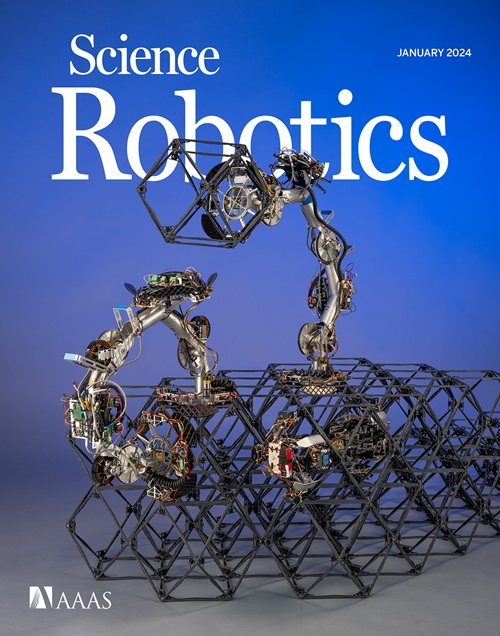学习腿式操纵器的羽毛球协调技巧
IF 27.5
1区 计算机科学
Q1 ROBOTICS
引用次数: 0
摘要
下肢和上肢之间的运动协调以及肢体控制与感知的协调是机器人技术的重大挑战,特别是在动态环境中。为此,我们介绍了一种使腿式移动机械手能够打羽毛球的方法,这项任务需要感知、运动和手臂摆动的精确协调。我们提出了一种统一的基于强化学习的全身视觉运动技能控制策略,涉及所有自由度,以实现有效的羽毛球跟踪和击球。该策略由使用真实摄像机数据的感知噪声模型提供信息,允许在模拟和部署之间保持一致的感知误差水平,并鼓励学习主动感知行为。我们的方法包括羽毛球预测模型和鲁棒运动控制的约束强化学习,以增强部署准备。在各种环境下的大量实验结果验证了机器人预测毽子轨迹的能力,有效地导航服务区域,并对人类球员进行精确打击,证明了在复杂和动态的运动场景中使用腿式移动机械手的可行性。本文章由计算机程序翻译,如有差异,请以英文原文为准。

Learning coordinated badminton skills for legged manipulators
Coordinating the motion between lower and upper limbs and aligning limb control with perception are substantial challenges in robotics, particularly in dynamic environments. To this end, we introduce an approach for enabling legged mobile manipulators to play badminton, a task that requires precise coordination of perception, locomotion, and arm swinging. We propose a unified reinforcement learning–based control policy for whole-body visuomotor skills involving all degrees of freedom to achieve effective shuttlecock tracking and striking. This policy is informed by a perception noise model that uses real-world camera data, allowing for consistent perception error levels between simulation and deployment and encouraging learned active perception behaviors. Our method includes a shuttlecock prediction model and constrained reinforcement learning for robust motion control to enhance deployment readiness. Extensive experimental results in a variety of environments validate the robot’s capability to predict shuttlecock trajectories, navigate the service area effectively, and execute precise strikes against human players, demonstrating the feasibility of using legged mobile manipulators in complex and dynamic sports scenarios.
求助全文
通过发布文献求助,成功后即可免费获取论文全文。
去求助
来源期刊

Science Robotics
Mathematics-Control and Optimization
CiteScore
30.60
自引率
2.80%
发文量
83
期刊介绍:
Science Robotics publishes original, peer-reviewed, science- or engineering-based research articles that advance the field of robotics. The journal also features editor-commissioned Reviews. An international team of academic editors holds Science Robotics articles to the same high-quality standard that is the hallmark of the Science family of journals.
Sub-topics include: actuators, advanced materials, artificial Intelligence, autonomous vehicles, bio-inspired design, exoskeletons, fabrication, field robotics, human-robot interaction, humanoids, industrial robotics, kinematics, machine learning, material science, medical technology, motion planning and control, micro- and nano-robotics, multi-robot control, sensors, service robotics, social and ethical issues, soft robotics, and space, planetary and undersea exploration.
 求助内容:
求助内容: 应助结果提醒方式:
应助结果提醒方式:


